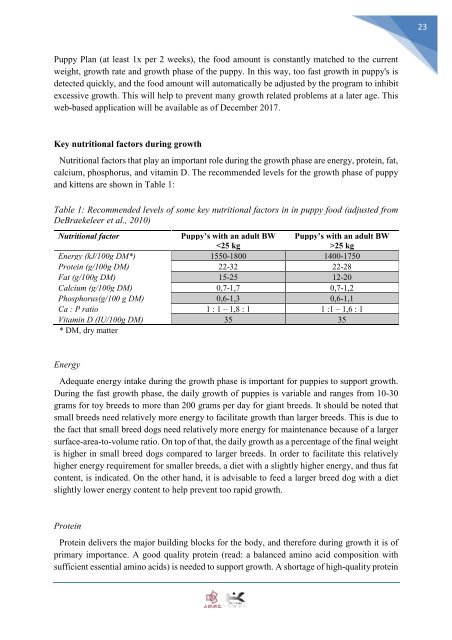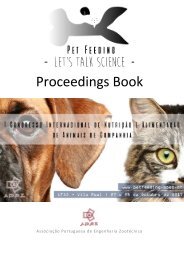Book of Proceedings I PetFeeding
Create successful ePaper yourself
Turn your PDF publications into a flip-book with our unique Google optimized e-Paper software.
23<br />
Puppy Plan (at least 1x per 2 weeks), the food amount is constantly matched to the current<br />
weight, growth rate and growth phase <strong>of</strong> the puppy. In this way, too fast growth in puppy's is<br />
detected quickly, and the food amount will automatically be adjusted by the program to inhibit<br />
excessive growth. This will help to prevent many growth related problems at a later age. This<br />
web-based application will be available as <strong>of</strong> December 2017.<br />
Key nutritional factors during growth<br />
Nutritional factors that play an important role during the growth phase are energy, protein, fat,<br />
calcium, phosphorus, and vitamin D. The recommended levels for the growth phase <strong>of</strong> puppy<br />
and kittens are shown in Table 1:<br />
Table 1: Recommended levels <strong>of</strong> some key nutritional factors in in puppy food (adjusted from<br />
DeBraekeleer et al., 2010)<br />
Nutritional factor<br />
Puppy’s with an adult BW<br />
25 kg<br />
Energy (kJ/100g DM*) 1550-1800 1400-1750<br />
Protein (g/100g DM) 22-32 22-28<br />
Fat (g/100g DM) 15-25 12-20<br />
Calcium (g/100g DM) 0,7-1,7 0,7-1,2<br />
Phosphorus(g/100 g DM) 0,6-1,3 0,6-1,1<br />
Ca : P ratio 1 : 1 – 1,8 : 1 1 :1 – 1,6 : 1<br />
Vitamin D (IU/100g DM) 35 35<br />
* DM, dry matter<br />
Energy<br />
Adequate energy intake during the growth phase is important for puppies to support growth.<br />
During the fast growth phase, the daily growth <strong>of</strong> puppies is variable and ranges from 10-30<br />
grams for toy breeds to more than 200 grams per day for giant breeds. It should be noted that<br />
small breeds need relatively more energy to facilitate growth than larger breeds. This is due to<br />
the fact that small breed dogs need relatively more energy for maintenance because <strong>of</strong> a larger<br />
surface-area-to-volume ratio. On top <strong>of</strong> that, the daily growth as a percentage <strong>of</strong> the final weight<br />
is higher in small breed dogs compared to larger breeds. In order to facilitate this relatively<br />
higher energy requirement for smaller breeds, a diet with a slightly higher energy, and thus fat<br />
content, is indicated. On the other hand, it is advisable to feed a larger breed dog with a diet<br />
slightly lower energy content to help prevent too rapid growth.<br />
Protein<br />
Protein delivers the major building blocks for the body, and therefore during growth it is <strong>of</strong><br />
primary importance. A good quality protein (read: a balanced amino acid composition with<br />
sufficient essential amino acids) is needed to support growth. A shortage <strong>of</strong> high-quality protein



